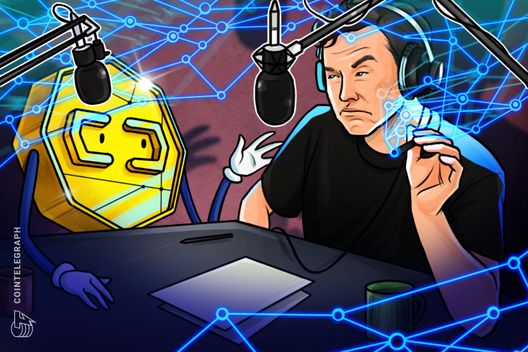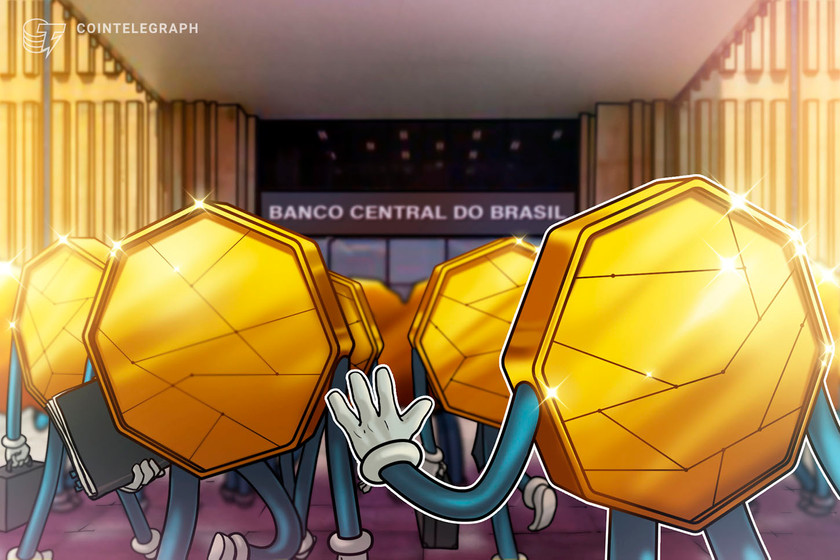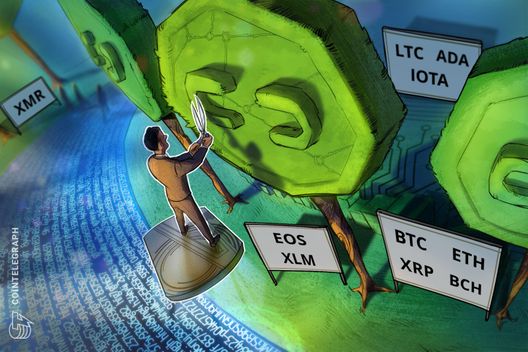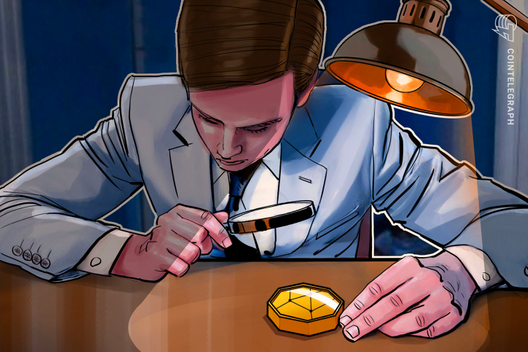Ethereum as a deflationary asset, explained
What is Bitcoin? How does blockchain work? How to mine cryptocurrency? We are glad to help you answer these questions with our quick guides in Explained section.
rn”,”seo_description”:”What is Bitcoin? How does blockchain work? How to mine cryptocurrency? We are glad to help you answer these questions with our quick guides in Explained section.”},”words_count”:621,”description”:”Deflationary tokens like Ethereum are the key to differentiating Web3 ecosystems from traditional capital markets.”,”author”:{“id”:1587,”title”:”Arunkumar Krishnakumar”,”url”:”arunkumar-krishnakumar”,”twitter”:””,”google_plus”:””,”photo”:”https://s3.cointelegraph.com/storage/uploads/view/9eb8857e029ccc4cb084a3acb28859e1.jpg”,”gender”:”male”,”description”:”Arun is the chief growth officer at Bullieverse. With a career spanning 20 years, Arun has spent time as a technology engineer, consultant, VC/Web3 investor and author. As an investor, he has over 20 portfolio companies, a few exits and sits on several boards. Arun has published two books, one on Web3 and the other on crisis management for venture firms. He is a social media influencer and an alum of the University of Oxford and the London School of Economics. Arun also has a crypto (mostly L1s) and an NFT portfolio (both PFPs and Utility). “,”facebook”:””,”email”:””,”linkedin”:””,”created_at”:”2022-06-11 15:35:40″,”updated_at”:”2022-09-20 20:09:37″,”deleted_at”:null,”innovation_circle_url”:null,”avatar”:”https://images.cointelegraph.com/images/150_aHR0cHM6Ly9zMy5jb2ludGVsZWdyYXBoLmNvbS9zdG9yYWdlL3VwbG9hZHMvdmlldy85ZWI4ODU3ZTAyOWNjYzRjYjA4NGEzYWNiMjg4NTllMS5qcGc=.jpg”,”hash”:”aHR0cHM6Ly9jb2ludGVsZWdyYXBoLmNvbS9hdXRob3JzL2FydW5rdW1hci1rcmlzaG5ha3VtYXI=”,”relativeUrl”:”https://cointelegraph.com/authors/arunkumar-krishnakumar”,”user_id”:1587,”language_id”:1,”name”:” Arunkumar Krishnakumar “,”desc”:”Arun is the chief growth officer at Bullieverse. With a career spanning 20 years, Arun has spent time as a technology engineer, consultant, VC/Web3 investor and author. As an investor, he has over 20 portfolio companies, a few exits and sits on several boards. Arun has published two books, one on Web3 and the other on crisis management for venture firms. He is a social media influencer and an alum of the University of Oxford and the London School of Economics. Arun also has a crypto (mostly L1s) and an NFT portfolio (both PFPs and Utility). “,”seo_title”:””,”seo_description”:””,”enabled”:1,”show_in_authors”:0,”show_in_experts”:0},”category_id”:65,”audio”:”https://s3.cointelegraph.com/audio/104958.27c4f65f-2472-462d-ae43-7ffc9c9d7f9d.mp3″,”tags”:[{“name”:”Blockchain”,”uri”:”/tags/blockchain”,”super”:1,”page_title”:”Blockchain News”},{“name”:”Decentralization”,”uri”:”/tags/decentralization”,”super”:0,”page_title”:”Decentralization News”},{“name”:”Ethereum”,”uri”:”/tags/ethereum”,”super”:1,”page_title”:”Ethereum News”},{“name”:”Web3″,”uri”:”/tags/web3″,”super”:0,”page_title”:””}],”tag_title”:”Blockchain”,”date”:”29 MINUTES AGO”,”badge”:{“title”:”Explained”,”label”:”default”},”qty”:8,”stats_pixel”:”“,”stats_pixel_url”:”https://zoa.cointelegraph.com/pixel?postId=104958®ionId=1″,”shares”:4,”infographic”:false,”sponsored”:false,”explained”:true,”press_release”:false,”show_referral”:false,”social_description”:”Deflationary tokens: The future of crypto? # Ethereum’s deflationary shift sparks a new trend in Web3 ecosystems. “,”social_translators”:{“clipboard_popup_label”:”Link copied”,”socialWechatFooterError”:”WeChat error”,”socialWechatFooterText”:”WeChat share”,”socialWechatHeaderText”:”WeChat share”},”social_shares”:{“post_id”:104958,”post_url”:”https://cointelegraph.com/explained/ethereum-as-a-deflationary-asset-explained”,”post_titles”:{“normal”:”Ethereum as a deflationary asset, explained”,”twitter”:”Ethereum as a deflationary asset, explained”},”post_text”:{“normal”:”Ethereum as a deflationary asset, explained”,”twitter”:”Ethereum as a deflationary asset, explained https://cointelegraph.com/explained/ethereum-as-a-deflationary-asset-explained via @cointelegraph”},”accounts”:{“twitter”:”@cointelegraph”}},”socials”:{“facebook”:{“url”:”https://www.facebook.com/sharer/sharer.php?u=https%3A%2F%2Fcointelegraph.com%2Fexplained%2Fethereum-as-a-deflationary-asset-explained”,”count”:null,”short”:”fb”,”fa”:”facebook”},”twitter”:{“url”:”https://twitter.com/intent/tweet?text=Ethereum+as+a+deflationary+asset%2C+explained https%3A%2F%2Fcointelegraph.com%2Fexplained%2Fethereum-as-a-deflationary-asset-explained via @cointelegraph”,”count”:null,”short”:”tw”,”fa”:”twitter”},”telegram”:{“url”:”https://telegram.me/share/url?url=https%3A%2F%2Fcointelegraph.com%2Fexplained%2Fethereum-as-a-deflationary-asset-explained &text=Ethereum+as+a+deflationary+asset%2C+explained”,”count”:null,”short”:”tg”,”fa”:”paper-plane”},”whatsapp”:{“url”:”https://api.whatsapp.com/send?text=Ethereum+as+a+deflationary+asset%2C+explained&href=https%3A%2F%2Fcointelegraph.com%2Fexplained%2Fethereum-as-a-deflationary-asset-explained”,”count”:null,”short”:”wu”,”fa”:”whatsapp”},”gplus”:{“url”:”https://plus.google.com/share?url=https%3A%2F%2Fcointelegraph.com%2Fexplained%2Fethereum-as-a-deflationary-asset-explained”,”count”:null,”short”:”gplus”,”fa”:”google-plus”},”reddit”:{“url”:”https://www.reddit.com/submit?url=https%3A%2F%2Fcointelegraph.com%2Fexplained%2Fethereum-as-a-deflationary-asset-explained&title=Ethereum+as+a+deflationary+asset%2C+explained”,”count”:null,”short”:”reddit”,”fa”:”reddit-alien”},”linkedin”:{“url”:”https://www.linkedin.com/shareArticle?mini=true&url=https%3A%2F%2Fcointelegraph.com%2Fexplained%2Fethereum-as-a-deflationary-asset-explained&title=Ethereum+as+a+deflationary+asset%2C+explained”,”count”:null,”short”:”li”,”fa”:”linkedin”}},”hide_disclaimer”:false,”elink”:”https://cointelegraph.com”,”etitle”:”Cointelegraph”,”elogo_x2″:”https://images.cointelegraph.com/images/528_aHR0cHM6Ly9zMy5jb2ludGVsZWdyYXBoLmNvbS9zdG9yYWdlL3VwbG9hZHMvdmlldy9hYjAzYTJhMmNlOWEyMWRjMWYwOTYxZDkxNzMxYzhiYS5wbmc=.png”,”elogo_x1″:”https://images.cointelegraph.com/images/260_aHR0cHM6Ly9zMy5jb2ludGVsZWdyYXBoLmNvbS9zdG9yYWdlL3VwbG9hZHMvdmlldy9hYjAzYTJhMmNlOWEyMWRjMWYwOTYxZDkxNzMxYzhiYS5wbmc=.png”,”elogo_svg”:false,”content”:[{“id”:4036,”post_id”:104958,”title”:”What is a deflationary cryptocurrency?”,”content”:”
Although cryptocurrencies are often promoted as investment opportunities, their primary purpose was originally to serve as an alternative form of currency. Considering this narrative, the rules of supply and demand apply to cryptocurrencies as to fiat currencies.
nn
An undergraduate economics student might say the basics of money, economy and market forces is balancing supply and demand. How much of an asset is in circulation versus the demand — how many people want that particular asset — helps decide its price. This equation between supply and demand underlies the fundamentals of all economies and also applies to cryptocurrencies.
nn
Deflationary cryptocurrency is one where the value of the crypto increases due to a reduction or stagnation in supply. This ensures that the coin’s market value is attractive for more people to invest in and can be used as a store of value. While deflationary cryptocurrencies look more attractive, not all are designed that way.
nn
Many well-known cryptocurrencies are not deflationary. In addition, there is often no supply limit to them. Some are disinflationary because inflation gradually reduces over time due to its tokenomics. Bitcoin (BTC), for instance, won’t be deflationary until all 21 million coins have been mined. Ether (ETH) was not deflationary until the “Merge” happened in September 2022.
nn
Related: Inflationary vs. deflationary cryptocurrencies, Explained
nnnn”,”created_at”:”2023-03-21 09:48:35″,”updated_at”:”2023-03-21 09:50:02″,”sort”:1,”translations”:{“id”:4029,”explained_post_id”:4036,”title_en”:”What is a deflationary cryptocurrency?”,”content_en”:”
Although cryptocurrencies are often promoted as investment opportunities, their primary purpose was originally to serve as an alternative form of currency. Considering this narrative, the rules of supply and demand apply to cryptocurrencies as to fiat currencies.
nn
An undergraduate economics student might say the basics of money, economy and market forces is balancing supply and demand. How much of an asset is in circulation versus the demand — how many people want that particular asset — helps decide its price. This equation between supply and demand underlies the fundamentals of all economies and also applies to cryptocurrencies.
nn
Deflationary cryptocurrency is one where the value of the crypto increases due to a reduction or stagnation in supply. This ensures that the coin’s market value is attractive for more people to invest in and can be used as a store of value. While deflationary cryptocurrencies look more attractive, not all are designed that way.
nn
Many well-known cryptocurrencies are not deflationary. In addition, there is often no supply limit to them. Some are disinflationary because inflation gradually reduces over time due to its tokenomics. Bitcoin (BTC), for instance, won’t be deflationary until all 21 million coins have been mined. Ether (ETH) was not deflationary until the “Merge” happened in September 2022.
nn
Related: Inflationary vs. deflationary cryptocurrencies, Explained
nnnn”,”title_es”:””,”content_es”:”nn”,”title_cn”:””,”content_cn”:”nn”,”title_de”:””,”content_de”:”nn”,”title_fr”:””,”content_fr”:”nn”,”title_it”:””,”content_it”:”nn”,”title_ar”:””,”content_ar”:”nn”,”title_br”:””,”content_br”:”nn”,”title_jp”:””,”content_jp”:”nn”,”created_at”:”2023-03-21 09:48:35″,”updated_at”:”2023-03-21 09:50:02″,”title_kr”:””,”content_kr”:”nn”,”title_tr”:””,”content_tr”:”nn”}},{“id”:4037,”post_id”:104958,”title”:”How does Ethereum fare against other deflationary tokens?”,”content”:”
Developers of tokens create deflationary mechanisms during the design of the economic model behind the token. The economic model — tokenomics — can be fundamental to how stakeholders add and accrue value in a Web3 ecosystem.
nn
The supply and demand dynamics of a token are decided at the level of development. Deflationary characteristics like burn mechanisms are decided as the economic model underlying the token is being developed. This can be a point-in-time process like with Bitcoin or an evolving mechanism like with Ethereum.
nn
When creating Bitcoin, Satoshi Nakamoto ensured there would only be a finite supply of 21 million. Once 21 million Bitcoin are mined, no new BTC can be created. This limited supply has helped the narrative that Bitcoin is a true store of value compared with fiat currencies that increase supply due to central bank monetary policies.
nn
In contrast, Ethereum had an inflationary supply at its inception. Ether supply was increasing at an annual rate of 4.5%. However, after the Ethereum Merge that saw it move from proof-of-work to proof-of-stake, it is now a non-inflationary asset due to its burn rate. The number of Ether burned in maintaining the network activity is more than the amount of Ether entering circulation.
nn
Implementing the EIP-1559 protocol has altered the economic nature of the Ethereum token by incorporating the burning of a fraction of the gas fees per transaction. As a result, some experts argue that Ethereum has become more deflationary than Bitcoin.
nn
As deflationary tokens are considered a better store of value, new tokens created for both protocol and application tiers may be designed to be deflationary.
nnnn”,”created_at”:”2023-03-21 09:48:56″,”updated_at”:”2023-03-21 09:50:02″,”sort”:2,”translations”:{“id”:4030,”explained_post_id”:4037,”title_en”:”How does Ethereum fare against other deflationary tokens?”,”content_en”:”
Developers of tokens create deflationary mechanisms during the design of the economic model behind the token. The economic model — tokenomics — can be fundamental to how stakeholders add and accrue value in a Web3 ecosystem.
nn
The supply and demand dynamics of a token are decided at the level of development. Deflationary characteristics like burn mechanisms are decided as the economic model underlying the token is being developed. This can be a point-in-time process like with Bitcoin or an evolving mechanism like with Ethereum.
nn
When creating Bitcoin, Satoshi Nakamoto ensured there would only be a finite supply of 21 million. Once 21 million Bitcoin are mined, no new BTC can be created. This limited supply has helped the narrative that Bitcoin is a true store of value compared with fiat currencies that increase supply due to central bank monetary policies.
nn
In contrast, Ethereum had an inflationary supply at its inception. Ether supply was increasing at an annual rate of 4.5%. However, after the Ethereum Merge that saw it move from proof-of-work to proof-of-stake, it is now a non-inflationary asset due to its burn rate. The number of Ether burned in maintaining the network activity is more than the amount of Ether entering circulation.
nn
Implementing the EIP-1559 protocol has altered the economic nature of the Ethereum token by incorporating the burning of a fraction of the gas fees per transaction. As a result, some experts argue that Ethereum has become more deflationary than Bitcoin.
nn
As deflationary tokens are considered a better store of value, new tokens created for both protocol and application tiers may be designed to be deflationary.
nnnn”,”title_es”:””,”content_es”:”nn”,”title_cn”:””,”content_cn”:”nn”,”title_de”:””,”content_de”:”nn”,”title_fr”:””,”content_fr”:”nn”,”title_it”:””,”content_it”:”nn”,”title_ar”:””,”content_ar”:”nn”,”title_br”:””,”content_br”:”nn”,”title_jp”:””,”content_jp”:”nn”,”created_at”:”2023-03-21 09:48:56″,”updated_at”:”2023-03-21 09:50:02″,”title_kr”:””,”content_kr”:”nn”,”title_tr”:””,”content_tr”:”nn”}},{“id”:4038,”post_id”:104958,”title”:”Has Ethereum’s transition to a deflationary token made it a more desirable asset?”,”content”:”
Investments in deflationary cryptocurrencies can yield growth and returns for investors. But being deflationary alone may not be a criterion to be identified as a better investment.
nn
Due to their supply cap, deflationary tokens are typically perceived as more valuable by holders and investors. This was also demonstrated by the rise of nonfungible tokens (NFTs), where the rarity of the NFTs often decided the prices. Limited supply driving prices higher was also true with the Ethereum Name Service (ENS), where some three-digit ENS names were sold for even more than 100 ETH.
nn
Ethereum may not necessarily be classified as a better asset after it became deflationary. Ethereum has a rich ecosystem that drives transactions on the chain, and as more Ether gets burned in the process, it causes deflation. An unused Ethereum blockchain wouldn’t be able to achieve this economic feat.
nn
The underlying chain fundamentals must remain strong for Ethereum to thrive as an investment. A chain with strong fundamentals typically has a developer ecosystem to create many applications that users widely adopt. As users flock to these applications, developers are encouraged to continue innovating.
nn
The resulting network effect would make Ethereum deflationary, making it a more attractive investment asset.
nnnn”,”created_at”:”2023-03-21 09:49:15″,”updated_at”:”2023-03-21 09:50:02″,”sort”:3,”translations”:{“id”:4031,”explained_post_id”:4038,”title_en”:”Has Ethereum’s transition to a deflationary token made it a more desirable asset?”,”content_en”:”
Investments in deflationary cryptocurrencies can yield growth and returns for investors. But being deflationary alone may not be a criterion to be identified as a better investment.
nn
Due to their supply cap, deflationary tokens are typically perceived as more valuable by holders and investors. This was also demonstrated by the rise of nonfungible tokens (NFTs), where the rarity of the NFTs often decided the prices. Limited supply driving prices higher was also true with the Ethereum Name Service (ENS), where some three-digit ENS names were sold for even more than 100 ETH.
nn
Ethereum may not necessarily be classified as a better asset after it became deflationary. Ethereum has a rich ecosystem that drives transactions on the chain, and as more Ether gets burned in the process, it causes deflation. An unused Ethereum blockchain wouldn’t be able to achieve this economic feat.
nn
The underlying chain fundamentals must remain strong for Ethereum to thrive as an investment. A chain with strong fundamentals typically has a developer ecosystem to create many applications that users widely adopt. As users flock to these applications, developers are encouraged to continue innovating.
nn
The resulting network effect would make Ethereum deflationary, making it a more attractive investment asset.
nnnn”,”title_es”:””,”content_es”:”nn”,”title_cn”:””,”content_cn”:”nn”,”title_de”:””,”content_de”:”nn”,”title_fr”:””,”content_fr”:”nn”,”title_it”:””,”content_it”:”nn”,”title_ar”:””,”content_ar”:”nn”,”title_br”:””,”content_br”:”nn”,”title_jp”:””,”content_jp”:”nn”,”created_at”:”2023-03-21 09:49:15″,”updated_at”:”2023-03-21 09:50:02″,”title_kr”:””,”content_kr”:”nn”,”title_tr”:””,”content_tr”:”nn”}},{“id”:4039,”post_id”:104958,”title”:”Who controls inflation in the Ethereum ecosystem?”,”content”:”
Centralized regulatory organizations typically govern the inflation of asset prices in traditional capital markets. Is that the same in Web3? Who ensures fair play?
nn
In the United States, the Federal Reserve (the Fed) assumes the responsibility of maintaining inflation at reasonable levels by implementing tools such as altering interest rates, bond-buying programs and money printing. This obligation is typically similar across most other nations. In Web3, inflation is controlled by the protocol’s monetary policy, which is determined by the community through decentralized governance.
nn
Deflationary mechanisms are interwoven into the tokenomics while creating the ecosystem. Where tokens have an unlimited supply, as the token ecosystem matures, there would be more opportunities for burn. Therefore, the organization managing the token must proactively identify these opportunities and embed them into the tokenomics to reduce the supply.
nn
The Ethereum Merge is a fine example of how the Ethereum supply and demand was tweaked to make it deflationary. Such significant tokenomics changes are typically proposed, approved and executed by a decentralized autonomous organization (DAO) that governs the token and the platform behind it.
nn
These tokenomics changes are then embedded into smart contracts as the rules of the ecosystem. Smart contracts drive the new business rules and the economic model of the ecosystem. As a result, DAOs could play a significant role in ensuring efficient and effective governance of the tokens.
nn
Since decentralization is one of the tenets of the blockchain world, an economic system not controlled by the founding teams, investors, venture capitalists and whales is crucial to delivering sustainable tokenomics based on sound business models.
nnnn”,”created_at”:”2023-03-21 09:49:33″,”updated_at”:”2023-03-21 09:50:02″,”sort”:4,”translations”:{“id”:4032,”explained_post_id”:4039,”title_en”:”Who controls inflation in the Ethereum ecosystem?”,”content_en”:”
Centralized regulatory organizations typically govern the inflation of asset prices in traditional capital markets. Is that the same in Web3? Who ensures fair play?
nn
In the United States, the Federal Reserve (the Fed) assumes the responsibility of maintaining inflation at reasonable levels by implementing tools such as altering interest rates, bond-buying programs and money printing. This obligation is typically similar across most other nations. In Web3, inflation is controlled by the protocol’s monetary policy, which is determined by the community through decentralized governance.
nn
Deflationary mechanisms are interwoven into the tokenomics while creating the ecosystem. Where tokens have an unlimited supply, as the token ecosystem matures, there would be more opportunities for burn. Therefore, the organization managing the token must proactively identify these opportunities and embed them into the tokenomics to reduce the supply.
nn
The Ethereum Merge is a fine example of how the Ethereum supply and demand was tweaked to make it deflationary. Such significant tokenomics changes are typically proposed, approved and executed by a decentralized autonomous organization (DAO) that governs the token and the platform behind it.
nn
These tokenomics changes are then embedded into smart contracts as the rules of the ecosystem. Smart contracts drive the new business rules and the economic model of the ecosystem. As a result, DAOs could play a significant role in ensuring efficient and effective governance of the tokens.
nn
Since decentralization is one of the tenets of the blockchain world, an economic system not controlled by the founding teams, investors, venture capitalists and whales is crucial to delivering sustainable tokenomics based on sound business models.
nnnn”,”title_es”:””,”content_es”:”nn”,”title_cn”:””,”content_cn”:”nn”,”title_de”:””,”content_de”:”nn”,”title_fr”:””,”content_fr”:”nn”,”title_it”:””,”content_it”:”nn”,”title_ar”:””,”content_ar”:”nn”,”title_br”:””,”content_br”:”nn”,”title_jp”:””,”content_jp”:”nn”,”created_at”:”2023-03-21 09:49:33″,”updated_at”:”2023-03-21 09:50:02″,”title_kr”:””,”content_kr”:”nn”,”title_tr”:””,”content_tr”:”nn”}}],”is_partner_material”:false,”commentsSection”:{“schemaEntityUrl”:”//cointelegraph.com/explained/ethereum-as-a-deflationary-asset-explained”,”list”:[],”amount”:0,”i18n”:{“addComment”:”Add a comment…”,”amountOnePostfix”:”Comment”,”amountPostfix”:”Comments”,”cancel”:”Cancel”,”delete”:”Delete”,”edit”:”Edit”,”errorBig”:”Comment text cannot be longer than 2000 characters”,”errorDuplicate”:”Duplicate comment”,”errorSmall”:”Comment text must be at least 2 characters long”,”hideButton”:”Hide comments”,”noComments”:” “,”commentOnModeration”:”Comment on moderation”,”postComment”:”Post”,”reply”:”Reply”,”showAllComments”:”Show All Comments”,”showButtonPostfix”:”comments”,”showButtonPrefix”:”Show”,”signIn”:”Sign in”,”update”:”Update comment”,”commentWasDeleted”:”This comment has been deleted”}},”related”:[{“id”:87280,”retina”:”https://images.cointelegraph.com/images/1480_aHR0cHM6Ly9zMy5jb2ludGVsZWdyYXBoLmNvbS91cGxvYWRzLzIwMjItMDUvZTk3ZGE2NDgtYTEwOS00YjE2LWJmZjEtNTg1MzM1ZTIxOGQ1LmpwZw==.jpg”,”img”:”https://images.cointelegraph.com/images/740_aHR0cHM6Ly9zMy5jb2ludGVsZWdyYXBoLmNvbS91cGxvYWRzLzIwMjItMDUvZTk3ZGE2NDgtYTEwOS00YjE2LWJmZjEtNTg1MzM1ZTIxOGQ1LmpwZw==.jpg”,”thumb”:”https://images.cointelegraph.com/images/370_aHR0cHM6Ly9zMy5jb2ludGVsZWdyYXBoLmNvbS91cGxvYWRzLzIwMjItMDUvZTk3ZGE2NDgtYTEwOS00YjE2LWJmZjEtNTg1MzM1ZTIxOGQ1LmpwZw==.jpg”,”thumb370″:”https://images.cointelegraph.com/images/370_aHR0cHM6Ly9zMy5jb2ludGVsZWdyYXBoLmNvbS91cGxvYWRzLzIwMjItMDUvZTk3ZGE2NDgtYTEwOS00YjE2LWJmZjEtNTg1MzM1ZTIxOGQ1LmpwZw==.jpg”,”amp_thumb”:”https://images.cointelegraph.com/images/150_aHR0cHM6Ly9zMy5jb2ludGVsZWdyYXBoLmNvbS91cGxvYWRzLzIwMjItMDUvZTk3ZGE2NDgtYTEwOS00YjE2LWJmZjEtNTg1MzM1ZTIxOGQ1LmpwZw==.jpg”,”thumb150″:”https://images.cointelegraph.com/images/150_aHR0cHM6Ly9zMy5jb2ludGVsZWdyYXBoLmNvbS91cGxvYWRzLzIwMjItMDUvZTk3ZGE2NDgtYTEwOS00YjE2LWJmZjEtNTg1MzM1ZTIxOGQ1LmpwZw==.jpg”,”url”:”https://cointelegraph.com/news/how-to-get-a-job-in-the-metaverse-and-web3″,”title”:”How to get a job in the Metaverse and Web3″,”lead”:”To land a job in the Metaverse and Web3, possess the right skills, interact and network with people, build your brand, create content, and increase your exposur…”,”leadfull”:””,”category_id”:19,”category_url”:”https://cointelegraph.com/category/analysis”,”category_title”:”Analysis”,”author_url”:”https://cointelegraph.com/authors/jagjit-singh”,”author_hash”:”aHR0cHM6Ly9jb2ludGVsZWdyYXBoLmNvbS9hdXRob3JzL2phZ2ppdC1zaW5naA==”,”author_title”:”Jagjit Singh”,”author_img”:”https://cointelegraph.com/assets/img/icons/author_male.jpg”,”date”:”MAY 31, 2022″,”flash_date”:”MAY 31, 2022″,”sponsored”:false,”press_release”:false,”sponsored_label”:”Sponsored”,”explained”:false,”badge”:{“title”:”How to crypto”,”label”:”default”},”published”:{“date”:”2022-05-31 13:11:39.000000″,”timezone_type”:3,”timezone”:”Europe/London”},”stat_uniqs”:37952,”rss_date”:”Tue, 31 May 2022 13:11:39 +0100″,”publishedW3″:”2022-05-31T13:11:39+01:00″,”show_referral”:true,”isMagazine”:false},{“id”:104590,”retina”:”https://images.cointelegraph.com/images/1480_aHR0cHM6Ly9zMy5jb2ludGVsZWdyYXBoLmNvbS91cGxvYWRzLzIwMjMtMDMvOTcxZDRkOGEtNjdiMS00NjJiLTk2NWUtZWIyMDYzMDczZWIwLmpwZw==.jpg”,”img”:”https://images.cointelegraph.com/images/740_aHR0cHM6Ly9zMy5jb2ludGVsZWdyYXBoLmNvbS91cGxvYWRzLzIwMjMtMDMvOTcxZDRkOGEtNjdiMS00NjJiLTk2NWUtZWIyMDYzMDczZWIwLmpwZw==.jpg”,”thumb”:”https://images.cointelegraph.com/images/370_aHR0cHM6Ly9zMy5jb2ludGVsZWdyYXBoLmNvbS91cGxvYWRzLzIwMjMtMDMvOTcxZDRkOGEtNjdiMS00NjJiLTk2NWUtZWIyMDYzMDczZWIwLmpwZw==.jpg”,”thumb370″:”https://images.cointelegraph.com/images/370_aHR0cHM6Ly9zMy5jb2ludGVsZWdyYXBoLmNvbS91cGxvYWRzLzIwMjMtMDMvOTcxZDRkOGEtNjdiMS00NjJiLTk2NWUtZWIyMDYzMDczZWIwLmpwZw==.jpg”,”amp_thumb”:”https://images.cointelegraph.com/images/150_aHR0cHM6Ly9zMy5jb2ludGVsZWdyYXBoLmNvbS91cGxvYWRzLzIwMjMtMDMvOTcxZDRkOGEtNjdiMS00NjJiLTk2NWUtZWIyMDYzMDczZWIwLmpwZw==.jpg”,”thumb150″:”https://images.cointelegraph.com/images/150_aHR0cHM6Ly9zMy5jb2ludGVsZWdyYXBoLmNvbS91cGxvYWRzLzIwMjMtMDMvOTcxZDRkOGEtNjdiMS00NjJiLTk2NWUtZWIyMDYzMDczZWIwLmpwZw==.jpg”,”url”:”https://cointelegraph.com/news/new-ethereum-standard-enables-web3-urls-that-can-t-be-censored”,”title”:”Forget HTTP: Ethereum has a new URL standard that can’t be blocked”,”lead”:”Under a newly rolled out Ethereum standard, DApps and NFTs can be accessed by internet users without the worry of centralized censorship.”,”leadfull”:””,”category_id”:2,”category_url”:”https://cointelegraph.com/category/latest-news”,”category_title”:”Latest News”,”author_url”:”https://cointelegraph.com/authors/felix-ng”,”author_hash”:”aHR0cHM6Ly9jb2ludGVsZWdyYXBoLmNvbS9hdXRob3JzL2ZlbGl4LW5n”,”author_title”:” Felix Ng “,”author_img”:”https://images.cointelegraph.com/images/32_aHR0cHM6Ly9zMy5jb2ludGVsZWdyYXBoLmNvbS9zdG9yYWdlL3VwbG9hZHMvdmlldy84MDEzZDA4NGU3YzBkNTI0MzY5YTRmZmYwZjQxNjI2ZS5qcGc=.jpg”,”date”:”MAR 15, 2023″,”flash_date”:”MAR 15, 2023″,”sponsored”:false,”press_release”:false,”sponsored_label”:”Sponsored”,”explained”:false,”badge”:{“title”:”Interview”,”label”:”default”},”published”:{“date”:”2023-03-15 10:11:17.000000″,”timezone_type”:3,”timezone”:”Europe/London”},”stat_uniqs”:64471,”rss_date”:”Wed, 15 Mar 2023 10:11:17 +0000″,”publishedW3″:”2023-03-15T10:11:17+00:00″,”show_referral”:true,”isMagazine”:false},{“id”:104609,”retina”:”https://images.cointelegraph.com/images/1480_aHR0cHM6Ly9zMy5jb2ludGVsZWdyYXBoLmNvbS9zdG9yYWdlL3VwbG9hZHMvdmlldy9lZTA1ZWE3ZjljOWFjYmE2M2I5NjJkYjkxNTkyYjJlMS5qcGc=.jpg”,”img”:”https://images.cointelegraph.com/images/740_aHR0cHM6Ly9zMy5jb2ludGVsZWdyYXBoLmNvbS9zdG9yYWdlL3VwbG9hZHMvdmlldy9lZTA1ZWE3ZjljOWFjYmE2M2I5NjJkYjkxNTkyYjJlMS5qcGc=.jpg”,”thumb”:”https://images.cointelegraph.com/images/370_aHR0cHM6Ly9zMy5jb2ludGVsZWdyYXBoLmNvbS9zdG9yYWdlL3VwbG9hZHMvdmlldy9lZTA1ZWE3ZjljOWFjYmE2M2I5NjJkYjkxNTkyYjJlMS5qcGc=.jpg”,”thumb370″:”https://images.cointelegraph.com/images/370_aHR0cHM6Ly9zMy5jb2ludGVsZWdyYXBoLmNvbS9zdG9yYWdlL3VwbG9hZHMvdmlldy9lZTA1ZWE3ZjljOWFjYmE2M2I5NjJkYjkxNTkyYjJlMS5qcGc=.jpg”,”amp_thumb”:”https://images.cointelegraph.com/images/150_aHR0cHM6Ly9zMy5jb2ludGVsZWdyYXBoLmNvbS9zdG9yYWdlL3VwbG9hZHMvdmlldy9lZTA1ZWE3ZjljOWFjYmE2M2I5NjJkYjkxNTkyYjJlMS5qcGc=.jpg”,”thumb150″:”https://images.cointelegraph.com/images/150_aHR0cHM6Ly9zMy5jb2ludGVsZWdyYXBoLmNvbS9zdG9yYWdlL3VwbG9hZHMvdmlldy9lZTA1ZWE3ZjljOWFjYmE2M2I5NjJkYjkxNTkyYjJlMS5qcGc=.jpg”,”url”:”https://cointelegraph.com/news/web3-needs-its-wordpress-moment-to-speed-up-positive-disruption”,”title”:”Web3 needs its ‘WordPress moment’ to speed up positive disruption”,”lead”:”Developers have barely scratched the surface when it comes to the potential of blockchain — here’s how to ramp up progress.”,”leadfull”:””,”category_id”:62,”category_url”:”https://cointelegraph.com/category/sponsored”,”category_title”:”Sponsored”,”author_url”:”https://cointelegraph.com/authors/serkan-keskin”,”author_hash”:”aHR0cHM6Ly9jb2ludGVsZWdyYXBoLmNvbS9hdXRob3JzL3Nlcmthbi1rZXNraW4=”,”author_title”:”Serkan Keskin”,”author_img”:”https://cointelegraph.com/assets/img/icons/author_male.jpg”,”date”:”MAR 16, 2023″,”flash_date”:”MAR 16, 2023″,”sponsored”:true,”press_release”:false,”sponsored_label”:”Sponsored”,”explained”:false,”badge”:{“title”:”Use Case”,”label”:”default”},”published”:{“date”:”2023-03-16 11:00:00.000000″,”timezone_type”:3,”timezone”:”Europe/London”},”stat_uniqs”:18893,”rss_date”:”Thu, 16 Mar 2023 11:00:00 +0000″,”publishedW3″:”2023-03-16T11:00:00+00:00″,”show_referral”:true,”isMagazine”:false},{“id”:104665,”retina”:”https://images.cointelegraph.com/images/1480_aHR0cHM6Ly9zMy5jb2ludGVsZWdyYXBoLmNvbS91cGxvYWRzLzIwMjMtMDMvZWYzZTc5M2ItMDM0Mi00ZjA0LTkzYzktODRmY2YzZjYxMDUxLmpwZw==.jpg”,”img”:”https://images.cointelegraph.com/images/740_aHR0cHM6Ly9zMy5jb2ludGVsZWdyYXBoLmNvbS91cGxvYWRzLzIwMjMtMDMvZWYzZTc5M2ItMDM0Mi00ZjA0LTkzYzktODRmY2YzZjYxMDUxLmpwZw==.jpg”,”thumb”:”https://images.cointelegraph.com/images/370_aHR0cHM6Ly9zMy5jb2ludGVsZWdyYXBoLmNvbS91cGxvYWRzLzIwMjMtMDMvZWYzZTc5M2ItMDM0Mi00ZjA0LTkzYzktODRmY2YzZjYxMDUxLmpwZw==.jpg”,”thumb370″:”https://images.cointelegraph.com/images/370_aHR0cHM6Ly9zMy5jb2ludGVsZWdyYXBoLmNvbS91cGxvYWRzLzIwMjMtMDMvZWYzZTc5M2ItMDM0Mi00ZjA0LTkzYzktODRmY2YzZjYxMDUxLmpwZw==.jpg”,”amp_thumb”:”https://images.cointelegraph.com/images/150_aHR0cHM6Ly9zMy5jb2ludGVsZWdyYXBoLmNvbS91cGxvYWRzLzIwMjMtMDMvZWYzZTc5M2ItMDM0Mi00ZjA0LTkzYzktODRmY2YzZjYxMDUxLmpwZw==.jpg”,”thumb150″:”https://images.cointelegraph.com/images/150_aHR0cHM6Ly9zMy5jb2ludGVsZWdyYXBoLmNvbS91cGxvYWRzLzIwMjMtMDMvZWYzZTc5M2ItMDM0Mi00ZjA0LTkzYzktODRmY2YzZjYxMDUxLmpwZw==.jpg”,”url”:”https://cointelegraph.com/news/euler-hacker-seemingly-taking-their-chances-sends-funds-to-crypto-mixer”,”title”:”Euler hacker seemingly taking their chances, sends funds to crypto mixer”,”lead”:”Before the move, the hacker apparently refunded at least one victim, leading to a slew of on-chain messages from other purported victims.”,”leadfull”:””,”category_id”:2,”category_url”:”https://cointelegraph.com/category/latest-news”,”category_title”:”Latest News”,”author_url”:”https://cointelegraph.com/authors/ciaran-lyons”,”author_hash”:”aHR0cHM6Ly9jb2ludGVsZWdyYXBoLmNvbS9hdXRob3JzL2NpYXJhbi1seW9ucw==”,”author_title”:” Ciaran Lyons “,”author_img”:”https://images.cointelegraph.com/images/32_aHR0cHM6Ly9zMy5jb2ludGVsZWdyYXBoLmNvbS9zdG9yYWdlL3VwbG9hZHMvdmlldy84N2U5YWFkYzlmYjA2NGQ3YmZhMDNjMGEzOTZhYTY0YS5qcGVn.jpeg”,”date”:”MAR 16, 2023″,”flash_date”:”MAR 16, 2023″,”sponsored”:false,”press_release”:false,”sponsored_label”:”Sponsored”,”explained”:false,”badge”:{“title”:”News”,”label”:”default”},”published”:{“date”:”2023-03-16 06:33:34.000000″,”timezone_type”:3,”timezone”:”Europe/London”},”stat_uniqs”:7018,”rss_date”:”Thu, 16 Mar 2023 06:33:34 +0000″,”publishedW3″:”2023-03-16T06:33:34+00:00″,”show_referral”:true,”isMagazine”:false},{“id”:104777,”retina”:”https://images.cointelegraph.com/images/1480_aHR0cHM6Ly9zMy5jb2ludGVsZWdyYXBoLmNvbS91cGxvYWRzLzIwMjMtMDMvMDc2NGNhMzItOWY2Yi00YzcxLTg1OWQtZDUyMjBkYjZlODE0LmpwZw==.jpg”,”img”:”https://images.cointelegraph.com/images/740_aHR0cHM6Ly9zMy5jb2ludGVsZWdyYXBoLmNvbS91cGxvYWRzLzIwMjMtMDMvMDc2NGNhMzItOWY2Yi00YzcxLTg1OWQtZDUyMjBkYjZlODE0LmpwZw==.jpg”,”thumb”:”https://images.cointelegraph.com/images/370_aHR0cHM6Ly9zMy5jb2ludGVsZWdyYXBoLmNvbS91cGxvYWRzLzIwMjMtMDMvMDc2NGNhMzItOWY2Yi00YzcxLTg1OWQtZDUyMjBkYjZlODE0LmpwZw==.jpg”,”thumb370″:”https://images.cointelegraph.com/images/370_aHR0cHM6Ly9zMy5jb2ludGVsZWdyYXBoLmNvbS91cGxvYWRzLzIwMjMtMDMvMDc2NGNhMzItOWY2Yi00YzcxLTg1OWQtZDUyMjBkYjZlODE0LmpwZw==.jpg”,”amp_thumb”:”https://images.cointelegraph.com/images/150_aHR0cHM6Ly9zMy5jb2ludGVsZWdyYXBoLmNvbS91cGxvYWRzLzIwMjMtMDMvMDc2NGNhMzItOWY2Yi00YzcxLTg1OWQtZDUyMjBkYjZlODE0LmpwZw==.jpg”,”thumb150″:”https://images.cointelegraph.com/images/150_aHR0cHM6Ly9zMy5jb2ludGVsZWdyYXBoLmNvbS91cGxvYWRzLzIwMjMtMDMvMDc2NGNhMzItOWY2Yi00YzcxLTg1OWQtZDUyMjBkYjZlODE0LmpwZw==.jpg”,”url”:”https://cointelegraph.com/news/what-are-the-howey-test-and-its-implications-for-cryptocurrency”,”title”:”What are the Howey test and its implications for cryptocurrency?”,”lead”:”The Howey test’s impact on cryptocurrency, explained — legal implications, compliance requirements and more.”,”leadfull”:””,”category_id”:19,”category_url”:”https://cointelegraph.com/category/analysis”,”category_title”:”Analysis”,”author_url”:”https://cointelegraph.com/authors/guneet-kaur”,”author_hash”:”aHR0cHM6Ly9jb2ludGVsZWdyYXBoLmNvbS9hdXRob3JzL2d1bmVldC1rYXVy”,”author_title”:” Guneet Kaur “,”author_img”:”https://images.cointelegraph.com/images/32_aHR0cHM6Ly9zMy5jb2ludGVsZWdyYXBoLmNvbS9zdG9yYWdlL3VwbG9hZHMvdmlldy9iNjlkNTQ5YWJmYjFmMjUzYzE0NDBmYjc4MzE5MzE5ZS5qcGc=.jpg”,”date”:”MAR 18, 2023″,”flash_date”:”MAR 18, 2023″,”sponsored”:false,”press_release”:false,”sponsored_label”:”Sponsored”,”explained”:false,”badge”:{“title”:”Overview”,”label”:”success”},”published”:{“date”:”2023-03-18 14:07:00.000000″,”timezone_type”:3,”timezone”:”Europe/London”},”stat_uniqs”:3294,”rss_date”:”Sat, 18 Mar 2023 14:07:00 +0000″,”publishedW3″:”2023-03-18T14:07:00+00:00″,”show_referral”:true,”isMagazine”:false},{“id”:104778,”retina”:”https://images.cointelegraph.com/images/1480_aHR0cHM6Ly9zMy5jb2ludGVsZWdyYXBoLmNvbS91cGxvYWRzLzIwMjMtMDMvODQ5OGNkOGUtN2FjZS00NTM4LWFhZWEtODIyMTQwZjk3NzJkLmpwZw==.jpg”,”img”:”https://images.cointelegraph.com/images/740_aHR0cHM6Ly9zMy5jb2ludGVsZWdyYXBoLmNvbS91cGxvYWRzLzIwMjMtMDMvODQ5OGNkOGUtN2FjZS00NTM4LWFhZWEtODIyMTQwZjk3NzJkLmpwZw==.jpg”,”thumb”:”https://images.cointelegraph.com/images/370_aHR0cHM6Ly9zMy5jb2ludGVsZWdyYXBoLmNvbS91cGxvYWRzLzIwMjMtMDMvODQ5OGNkOGUtN2FjZS00NTM4LWFhZWEtODIyMTQwZjk3NzJkLmpwZw==.jpg”,”thumb370″:”https://images.cointelegraph.com/images/370_aHR0cHM6Ly9zMy5jb2ludGVsZWdyYXBoLmNvbS91cGxvYWRzLzIwMjMtMDMvODQ5OGNkOGUtN2FjZS00NTM4LWFhZWEtODIyMTQwZjk3NzJkLmpwZw==.jpg”,”amp_thumb”:”https://images.cointelegraph.com/images/150_aHR0cHM6Ly9zMy5jb2ludGVsZWdyYXBoLmNvbS91cGxvYWRzLzIwMjMtMDMvODQ5OGNkOGUtN2FjZS00NTM4LWFhZWEtODIyMTQwZjk3NzJkLmpwZw==.jpg”,”thumb150″:”https://images.cointelegraph.com/images/150_aHR0cHM6Ly9zMy5jb2ludGVsZWdyYXBoLmNvbS91cGxvYWRzLzIwMjMtMDMvODQ5OGNkOGUtN2FjZS00NTM4LWFhZWEtODIyMTQwZjk3NzJkLmpwZw==.jpg”,”url”:”https://cointelegraph.com/news/ai-set-to-benefit-from-blockchain-based-data-infrastructure”,”title”:”AI set to benefit from blockchain-based data infrastructure “,”lead”:”Several data infrastructure and intelligence use cases take a decentralized approach to provide AI functionalities.”,”leadfull”:””,”category_id”:19,”category_url”:”https://cointelegraph.com/category/analysis”,”category_title”:”Analysis”,”author_url”:”https://cointelegraph.com/authors/arunkumar-krishnakumar”,”author_hash”:”aHR0cHM6Ly9jb2ludGVsZWdyYXBoLmNvbS9hdXRob3JzL2FydW5rdW1hci1rcmlzaG5ha3VtYXI=”,”author_title”:” Arunkumar Krishnakumar “,”author_img”:”https://images.cointelegraph.com/images/32_aHR0cHM6Ly9zMy5jb2ludGVsZWdyYXBoLmNvbS9zdG9yYWdlL3VwbG9hZHMvdmlldy85ZWI4ODU3ZTAyOWNjYzRjYjA4NGEzYWNiMjg4NTllMS5qcGc=.jpg”,”date”:”MAR 17, 2023″,”flash_date”:”MAR 17, 2023″,”sponsored”:false,”press_release”:false,”sponsored_label”:”Sponsored”,”explained”:false,”badge”:{“title”:”Analysis”,”label”:”info”},”published”:{“date”:”2023-03-17 13:55:00.000000″,”timezone_type”:3,”timezone”:”Europe/London”},”stat_uniqs”:2168,”rss_date”:”Fri, 17 Mar 2023 13:55:00 +0000″,”publishedW3″:”2023-03-17T13:55:00+00:00″,”show_referral”:true,”isMagazine”:false}]}” :shares=”{“facebook”:{“url”:”https://www.facebook.com/sharer/sharer.php?u=%URL%”,”icon”:”facebook”,”title”:”Facebook”,”sizesAllowed”:[{“size”:”lg”,”label”:”Large devices”,”breakpoint”:”> 1200px”},{“size”:”md”,”label”:”Medium devices”,”breakpoint”:”> 992px”},{“size”:”sm”,”label”:”Small tablets”,”breakpoint”:”> 768px”},{“size”:”xs”,”label”:”Smartphones”,”breakpoint”:”> 480px”},{“size”:”xxs”,”label”:”Extra small devices”,”breakpoint”:”< 480px"}],"position":1,"status":true},"twitter":{"url":"https://twitter.com/intent/tweet?text=%TEXT%","icon":"twitter","title":"Twitter","position":2,"status":true,"sizesAllowed":[{"size":"xxs","label":"Extra small devices","breakpoint":"< 480px"},{"size":"xs","label":"Smartphones","breakpoint":"> 480px”},{“size”:”sm”,”label”:”Small tablets”,”breakpoint”:”> 768px”},{“size”:”md”,”label”:”Medium devices”,”breakpoint”:”> 992px”},{“size”:”lg”,”label”:”Large devices”,”breakpoint”:”> 1200px”}]},”telegram”:{“url”:”https://t.me/share/url?url=%URL%&text=%TEXT%”,”icon”:”telegram”,”title”:”Telegram”,”position”:3,”status”:true,”sizesAllowed”:[{“size”:”xxs”,”label”:”Extra small devices”,”breakpoint”:”< 480px"},{"size":"xs","label":"Smartphones","breakpoint":"> 480px”},{“size”:”sm”,”label”:”Small tablets”,”breakpoint”:”> 768px”},{“size”:”md”,”label”:”Medium devices”,”breakpoint”:”> 992px”},{“size”:”lg”,”label”:”Large devices”,”breakpoint”:”> 1200px”}]},”linkedin”:{“url”:”https://www.linkedin.com/shareArticle?mini=true&url=%URL%&title=%TITLE%”,”icon”:”linked-in”,”title”:”LinkedIn”,”position”:5,”status”:true,”sizesAllowed”:[{“size”:”xxs”,”label”:”Extra small devices”,”breakpoint”:”< 480px"},{"size":"xs","label":"Smartphones","breakpoint":"> 480px”},{“size”:”sm”,”label”:”Small tablets”,”breakpoint”:”> 768px”},{“size”:”md”,”label”:”Medium devices”,”breakpoint”:”> 992px”},{“size”:”lg”,”label”:”Large devices”,”breakpoint”:”> 1200px”}]},”copy”:{“url”:”%URL%”,”icon”:”copy”,”position”:7,”title”:”Copy Link”,”sizesAllowed”:[{“size”:”xxs”,”label”:”Extra small devices”,”breakpoint”:”< 480px"},{"size":"xs","label":"Smartphones","breakpoint":"> 480px”},{“size”:”sm”,”label”:”Small tablets”,”breakpoint”:”> 768px”},{“size”:”md”,”label”:”Medium devices”,”breakpoint”:”> 992px”},{“size”:”lg”,”label”:”Large devices”,”breakpoint”:”> 1200px”}],”status”:true},”whatsapp”:{“url”:”https://wa.me/?text=%TITLE% %URL%”,”icon”:”whats-app”,”title”:”Whatsapp”,”sizesAllowed”:[{“size”:”xxs”,”label”:”Extra small devices”,”breakpoint”:”< 480px"},{"size":"xs","label":"Smartphones","breakpoint":"> 480px”},{“size”:”sm”,”label”:”Small tablets”,”breakpoint”:”> 768px”},{“size”:”md”,”label”:”Medium devices”,”breakpoint”:”> 992px”},{“size”:”lg”,”label”:”Large devices”,”breakpoint”:”> 1200px”}],”position”:6,”status”:true},”reddit”:{“url”:”https://www.reddit.com/submit?url=%URL%&title=%TITLE%”,”icon”:”reddit”,”title”:”Reddit”,”sizesAllowed”:[{“size”:”xxs”,”label”:”Extra small devices”,”breakpoint”:”< 480px"},{"size":"xs","label":"Smartphones","breakpoint":"> 480px”},{“size”:”sm”,”label”:”Small tablets”,”breakpoint”:”> 768px”},{“size”:”md”,”label”:”Medium devices”,”breakpoint”:”> 992px”},{“size”:”lg”,”label”:”Large devices”,”breakpoint”:”> 1200px”}],”position”:4,”status”:true}}” is=”ExplainedPostPage”>
Although cryptocurrencies are often promoted as investment opportunities, their primary purpose was originally to serve as an alternative form of currency. Considering this narrative, the rules of supply and demand apply to cryptocurrencies as to fiat currencies.
An undergraduate economics student might say the basics of money, economy and market forces is balancing supply and demand. How much of an asset is in circulation versus the demand — how many people want that particular asset — helps decide its price. This equation between supply and demand underlies the fundamentals of all economies and also applies to cryptocurrencies.
Deflationary cryptocurrency is one where the value of the crypto increases due to a reduction or stagnation in supply. This ensures that the coin’s market value is attractive for more people to invest in and can be used as a store of value. While deflationary cryptocurrencies look more attractive, not all are designed that way.
Many well-known cryptocurrencies are not deflationary. In addition, there is often no supply limit to them. Some are disinflationary because inflation gradually reduces over time due to its tokenomics. Bitcoin (BTC), for instance, won’t be deflationary until all 21 million coins have been mined. Ether (ETH) was not deflationary until the “Merge” happened in September 2022.
Related: Inflationary vs. deflationary cryptocurrencies, Explained
Developers of tokens create deflationary mechanisms during the design of the economic model behind the token. The economic model — tokenomics — can be fundamental to how stakeholders add and accrue value in a Web3 ecosystem.
The supply and demand dynamics of a token are decided at the level of development. Deflationary characteristics like burn mechanisms are decided as the economic model underlying the token is being developed. This can be a point-in-time process like with Bitcoin or an evolving mechanism like with Ethereum.
When creating Bitcoin, Satoshi Nakamoto ensured there would only be a finite supply of 21 million. Once 21 million Bitcoin are mined, no new BTC can be created. This limited supply has helped the narrative that Bitcoin is a true store of value compared with fiat currencies that increase supply due to central bank monetary policies.
In contrast, Ethereum had an inflationary supply at its inception. Ether supply was increasing at an annual rate of 4.5%. However, after the Ethereum Merge that saw it move from proof-of-work to proof-of-stake, it is now a non-inflationary asset due to its burn rate. The number of Ether burned in maintaining the network activity is more than the amount of Ether entering circulation.
Implementing the EIP-1559 protocol has altered the economic nature of the Ethereum token by incorporating the burning of a fraction of the gas fees per transaction. As a result, some experts argue that Ethereum has become more deflationary than Bitcoin.
As deflationary tokens are considered a better store of value, new tokens created for both protocol and application tiers may be designed to be deflationary.
Investments in deflationary cryptocurrencies can yield growth and returns for investors. But being deflationary alone may not be a criterion to be identified as a better investment.
Due to their supply cap, deflationary tokens are typically perceived as more valuable by holders and investors. This was also demonstrated by the rise of nonfungible tokens (NFTs), where the rarity of the NFTs often decided the prices. Limited supply driving prices higher was also true with the Ethereum Name Service (ENS), where some three-digit ENS names were sold for even more than 100 ETH.
Ethereum may not necessarily be classified as a better asset after it became deflationary. Ethereum has a rich ecosystem that drives transactions on the chain, and as more Ether gets burned in the process, it causes deflation. An unused Ethereum blockchain wouldn’t be able to achieve this economic feat.
The underlying chain fundamentals must remain strong for Ethereum to thrive as an investment. A chain with strong fundamentals typically has a developer ecosystem to create many applications that users widely adopt. As users flock to these applications, developers are encouraged to continue innovating.
The resulting network effect would make Ethereum deflationary, making it a more attractive investment asset.
Centralized regulatory organizations typically govern the inflation of asset prices in traditional capital markets. Is that the same in Web3? Who ensures fair play?
In the United States, the Federal Reserve (the Fed) assumes the responsibility of maintaining inflation at reasonable levels by implementing tools such as altering interest rates, bond-buying programs and money printing. This obligation is typically similar across most other nations. In Web3, inflation is controlled by the protocol’s monetary policy, which is determined by the community through decentralized governance.
Deflationary mechanisms are interwoven into the tokenomics while creating the ecosystem. Where tokens have an unlimited supply, as the token ecosystem matures, there would be more opportunities for burn. Therefore, the organization managing the token must proactively identify these opportunities and embed them into the tokenomics to reduce the supply.
The Ethereum Merge is a fine example of how the Ethereum supply and demand was tweaked to make it deflationary. Such significant tokenomics changes are typically proposed, approved and executed by a decentralized autonomous organization (DAO) that governs the token and the platform behind it.
These tokenomics changes are then embedded into smart contracts as the rules of the ecosystem. Smart contracts drive the new business rules and the economic model of the ecosystem. As a result, DAOs could play a significant role in ensuring efficient and effective governance of the tokens.
Since decentralization is one of the tenets of the blockchain world, an economic system not controlled by the founding teams, investors, venture capitalists and whales is crucial to delivering sustainable tokenomics based on sound business models.









